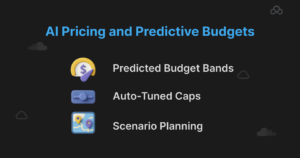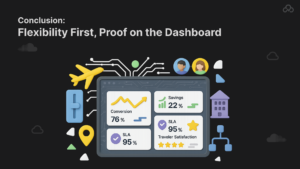Remote work didn’t end corporate travel; it rewired it. Fewer same-day hops. More team offsites and blended trips. Sharper scrutiny on whether travel moves pipeline, retention, or culture. Modern business travel technology now has to meet people where they plan, chat, calendars, mobile, and still keep policy, payments, and servicing tight. For travel B2B buyers, the bar is higher: adapt to distributed work, prove savings, maintain duty of care, and make it feel smooth for the traveler.
Policy-Aware Bookings for Distributed Teams
Old rules (route caps + preferred hotels) were built for hub offices. Today, policy must flex by home base, hub city, and trip purpose, without becoming chaos. Leading business travel technology evaluates:
– Geo-indexed caps per origin/destination, not one global ceiling.
– Purpose codes (client meeting, training, offsite, onboarding) that switch approval paths.
– Hybrid approvals: auto-approve inside cap and carbon threshold; escalate only when spend or risk drifts.
Result: fewer exceptions and cleaner audits. When the very first results already respect the program, travelers stop “booking around” the tool.
Travel Personalization That Still Enforces Policy
Consumer personalization equals endless options. In corporate, travel personalization should shrink the list to the right options that obey the rules:
– Hotels ranked for walkability to the venue, reliable workspace, and meeting-grade Wi-Fi.
– Itinerary suggestions that avoid brittle connections and respect constraints (e.g., “late return Monday” after a weekend offsite).
– Rail or car when door-to-door time beats air on key corridors, and policy allows it.
The effect is simple: faster decisions, fewer exceptions, happier travelers. And yes, it keeps the travel B2B program in control.
AI Pricing and Predictive Budgets

Volatile fares + short planning cycles = budget risk. AI pricing addresses it with lane-level forecasts, “buy now vs wait” signals, and dynamic budgets per route/date.
What you gain:
1. Predicted budget bands (with confidence) at request time, so approvers can weigh risk before they click yes.
2. Auto-tuned caps when markets swing, fewer “policy exception” emails, more compliant trips.
3. Scenario planning for offsites: compare hub cities, arrival waves, and two-night patterns, then lock when the curve tilts in your favor.
Finance sees fewer surprises. Travel managers get proof, not anecdotes. This is where business travel technology earns trust.
Roaming and Remote Workers’ Duty of Care
The duty of care has expanded to include everyone who occasionally travels from “anywhere,” not just road warriors. Contemporary stacks combine check-ins, risk feeds, and itineraries:
– alerts for weather, disruptions, or security incidents that are location-aware.
– escalation routes connected to HR/security contacts and in-app acknowledgements.
– logs that are ready for an audit that detail who was contacted, when, and how.
Explainability is just as important to travel B2B buyers as coverage. It doesn’t matter if a compliance officer is unable to follow the paper trail.
NDC / Offers & Orders Without Losing Control
Airlines are retailing richer bundles via NDC and Offers & Orders. Content is better; servicing is harder. Solid travel agency software fixes the pain by normalizing content and keeping mid-/back-office intact:
– Dual ingestion (legacy + NDC) with clear fare-family mapping.
– Exchanges, refunds, involuntary changes, handled without throwing travelers into a phone queue.
– Policy and analytics that survive fragmented sources.
NDC is table stakes now. The differentiator is whether your business travel technology can service orders at scale without breaking SLAs.
Collaboration-Native Booking and Support
Distributed teams live in chat and calendars. So should booking.
– Search, hold, and approve directly inside Slack/Teams, context preserved.
– Auto-attach trip details to calendar blocks; attendees see logistics without hunting emails.
– Escalate to an agent with the full thread, no re-explaining the situation.
That combination drops handle time, reduces dropped approvals, and gives managers clean visibility.
Payments, Receipts, and Tax for Anywhere Workers
Remote travel creates edge cases: mixed personal/business legs, regional tax quirks, per-diems that vary by jurisdiction. Modern travel agency software links booking, payments, and expense so finance doesn’t have to chase paper later:
– Virtual cards per trip with MCC/amount controls.
– Automatic receipt capture, proper VAT/GST tagging, and exports to finance.
– Policy-aware per-diem suggestions at quote time, before someone overspends.
When payments line up with policy at booking, reconciliation becomes boring (that’s the goal).
Mini Case Snapshots (short and concrete)
1. Global SaaS offsite (180 travelers): Policy-aware results clustered arrivals; walkable hotels ranked first; AI pricing locked fares two weeks earlier than usual. Net: ~11% savings vs lane averages.
2. Consulting firm with roaming teams: Slack-native booking cut first-response to under four minutes; preserved chat history on agent hand-off, dropping handle time by ~22%.
3. Manufacturing company: NDC content increased premium-economy attachment on long-haul sales trips; servicing SLAs held after back-office upgrades. The travel B2B team tracked “savings vs predicted budget” to prove impact.
Conclusion: Flexibility First, Proof on the Dashboard

Remote work pushed corporate travel from routine to purposeful. The platforms that win flex policy by persona, deliver the right content (including NDC) without breaking servicing, and use AI pricing plus travel personalization to cut effort and cost. The rest is hygiene: collaboration-native support, modern payments, and clear duty of care.
Treat every release as an experiment. Baseline today’s funnel, launch targeted pilots, and instrument the outcomes you’ll defend in the QBR: conversion, savings vs predicted budget, exchange/refund SLA, deflection, and traveler CSAT. Then iterate in 90-day loops, keep what moves a KPI, pause what doesn’t, and expand only after the numbers hold across lanes and markets.
Do that consistently and business travel technology becomes a lever, not a line item: a system that adapts to distributed work, proves compliance without friction, and channels spend into trips that actually move the business and the business travel technology. In other words, flexibility up front, evidence on the dashboard, exactly what modern travel B2B programs need.
Technical FAQs
How does AI pricing work inside policy without generating more exceptions?
AI pricing outputs a predicted budget band per route/date and a buy-now/wait signal. Policy uses that band as a dynamic cap, auto-approve inside, escalate beyond with justification. You lower exception volume during volatility and keep audits clean.
What’s the safest entry point for travel personalization in B2B?
Start with compliant defaults: hotel proximity to venues, workspace quality, and room types that reduce service tickets. Add traveler preferences where they don’t conflict with program rules. This form of travel personalization boosts adoption without chaos.
Can we adopt NDC without breaking exchanges and refunds?
Yes, if your stack normalizes content and your mid-/back-office handles order changes end-to-end. Require dual pipes (legacy + NDC), test involuntary changes, and monitor exchange SLA by content source. The right travel agency software makes it routine.
What adjustments should duty of care make for employees who work remotely and don’t travel often?
Make use of risk-tiered check-ins, itinerary ingestion (optional personal legs included), and program-wide location consent. Create logs that are audit-ready, displaying alerts, contact attempts, and results. Explainability is important in contemporary B2B travel programs.
Where should booking live in a distributed company, portal, chat, or calendar?
All three. Start in chat for speed; attach context to the calendar; fall back to the portal for complex trips. Business travel technology should meet travelers where they work.
Which KPIs prove value in 2025?
Savings vs predicted budget (lane-level)
Exchange/refund SLA (legacy vs NDC)
Attachment rate (seat, bag, Wi-Fi, hotel workspace)
Duty-of-care response compliance
Booking cycle time (chat/calendar start → confirmed)
Do you like to read more educational content? Read our blogs at Cloudastra Technologies or contact us for business enquiry at Cloudastra Contact Us.